Centenary Radio: The Race to Be First in St. Louis Radio
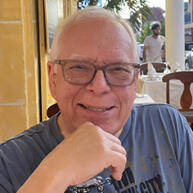
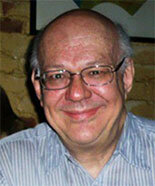
[March 2022] It was in March 1922 when the broadcast industry really got a full head of steam. Some 60 stations were granted licenses that month from manufacturers to newspapers to religious groups. In St. Louis, too, we see how interest grew and stations went on the air to satisfy that interest. Frank Absher has been chronicling the St. Louis market for many years. Here he notes several pioneers.
Pinpointing the exact start of local radio in many places is not easy.
While we can fairly easily trace the Department of Commerce (DOC) license grants, initial broadcasts could be days or weeks later – sometimes a licensed station never made it on the air! Additionally, many early stations started as amateur or experimental stations.
It was after a couple years of experimentation with radio broadcasting, St. Louisans saw these local efforts pay off with the awarding of two licenses from the Department of Commerce (DOC) in March of 1922. And as was the case in other cities, there will always be an unsolved mystery as to which entity was the first “on the air.”
WHO’S ON FIRST IN ST. LOUIS
In terms of licensing, the St. Louis Post-Dispatch was “first,” receiving its permit for KSD on March 14, 1922. The license for WEW, the radio station of St. Louis University, came a week later on March 21.
But both stations had been broadcasting prior to receiving their licenses. And as for which station was “first,” it depends on how you define that term.
As early as 1912, St. Louis University was known to be experimenting with wireless broadcasting of Morse Code to disseminate weather information for agricultural interests. It did so for five years as station 9YK, until the government shut down the broadcasts because of the First World War.
During that war, the campus hosted and schooled military radio operators, training them for the war effort. The Morse Code weather info returned to the airwaves at 9YK in 1919, and on April 26, 1921, the university’s president, Rev. William F. Robinson, read the day’s weather forecast over the wireless airwaves.
This broadcast was the first of two daily audio weather updates on 9YK.
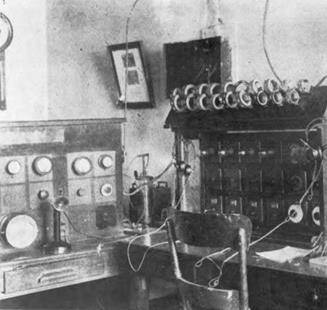
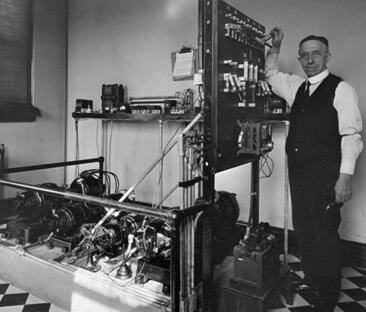
Farm market reports were added on August 22.
MEANWHILE, DOWN THE STREET
Twenty-five blocks east of the St. Louis University campus, money from the Pulitzer Publishing Company was funding the development of another radio station, one that would become KSD.
The transmitter was produced by Lester Benson and William Wood, two brilliant young engineers, who had also built a transmitters for WEW.
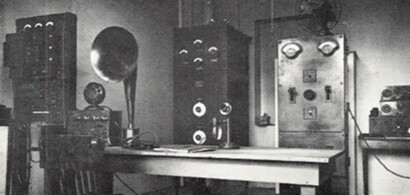 KDS’s first transmitter room – 1922
KDS’s first transmitter room – 1922
The first public broadcast of that station was heard on February 14, 1922, when Professor Walter Upson of Washington University gave a lecture on the development of radio, followed by a musical number performed at the American Theater. Pulitzer’s Post-Dispatch newspaper had experimented with “wireless telephony” to cover a major golf tournament in St. Louis the previous year, with reporters sending their news back to the newspaper offices via an electronic instrument.
Some confusion clouded the delivery of KSD’s license. Company documents show the call letter assignment on March 8, 1922, and a program was broadcast over the station’s 20-Watt transmitter the following evening.
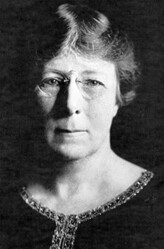 The first voice heard on that broadcast was that of the person who would be instrumental in the station’s early development, Miss Virginia Jones (often referred to as V. A. L. Jones).
The first voice heard on that broadcast was that of the person who would be instrumental in the station’s early development, Miss Virginia Jones (often referred to as V. A. L. Jones).
Interestingly, the station’s license for broadcasting was not actually issued until six days after the call letter assignment, so it appears the station jumped the gun on its “first” broadcast.
HELLO, WE ARE HERE … MOSTLY
Like WEW, KSD acknowledged that they were not ready to do any extended broadcasting on a regular basis.
In fact, the “official” KSD inaugural broadcast came later, on June 26. The extent of the Pulitzer money and civic influence was evident in that official opening broadcast, with speeches from the Mayor, Chamber of Commerce President, a fanfare from a military bugler and music from the orchestra at the Hotel Statler.
But then, within a few weeks, KSD’s broadcasts were temporarily minimized when a fire broke out in its small studios at the Post-Dispatch Building.
A decade later, KSD increased to 5000 Watts daytime, with 1000 Watts at night, increasing nighttime power to 5000 Watts by adding a directional array in 1948.
For a while in the 1980s, when Pulitzer was forced to sell, the call was changed to KUSA, and the format to country programming in AM Stereo. After another sale, the calls and talk format reverted ten years later to KSD. But even an historic three-letter call did not stick for long – three years later, in 1997, new ownership changed to KTRS to provide a clean break from the identities of stations on the frequency.
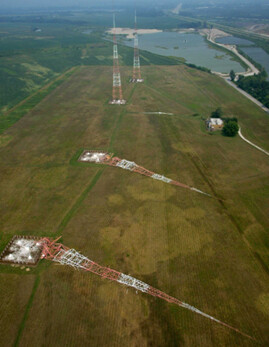
Curiously, the station suffered another catastrophic physical issue in July 2006 when a storm with 92 mile-an-hour winds fractured the insulators and knocked down two of the four towers then in use for the station’s nighttime array – one of them being the daytime non-directional tower.
Fortunately station engineer Mike Breitenstein had recently installed a second non-directional network on one of the towers that stayed up. The station ran 1250 Watts ND at night until the array could be repaired – which took a while as they had to deal with a government environmental protection agency.
Today the station still operates as a Talk/Sports station.
AND ANOTHER PIONEER
There was a third player in the early radio history of St. Louis – the Benwood Company.
Lester Benson and William Wood, who had built transmitters for both WEW and KSD also built a unit for themselves and began experimental broadcasts in February of 1922.
The two had previously been responsible for St. Louis’ first radio broadcast – a bootleg broadcast from their home-based transmitter – on November 2, 1920, when they reported (Correctly, unlike KDKA) the results of the Harding-Cox Presidential election.
Now their goal was procurement of a commercial license.

NOT SO SIMPLE AND EASY
Their first effort toward that goal came with an experimental broadcast February 9, 1922.
But after a second effort, the two were notified by the government’s radio inspection unit that they could no longer continue broadcasting to the general public since theirs was still an amateur broadcast license. After going through the proper channels, the two were issued a commercial license on April 5, 1922, to operate station WEB, St. Louis’ third commercial station.
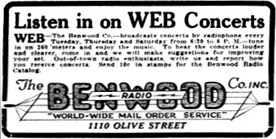
100 YEARS LATER
Today the WEW calls can still be found at its frequency of 770 kHz, but the three-letter KSD calls are gone from the AM band. WEB suffered an even worse fate.
WEW, which got its start at a Jesuit University, went through a long phase of commercial ownership and has since become a brokered daytimer owned by Birach Broadcasting.
As noted, the KSD calls returned when EZ Communications bought the station, but later, in a 1997 ownership change, Tim Dorsey of CH Holdings decided to drop them and make a clean break from the frequency’s past identities. Today at 550 you will hear Talk/Sports KTRS.
GONE FOREVER
It took 99+ years, but the third station from 1922 did not make it to 100.
WEB became WIL. More ownership changes led a change in 1991 to WRTH. Then it was back to WIL, but not for long. Bonneville, which sold it, did not sell the rights to the WIL call sign, so the station was renamed KZQZ. But then things went downhill.
The new owner was controlled by a convicted felon, and the FCC took the license (and three others) away. Even worse, no bids were made on any of the stations in July 2021, so this WEB/WIL/WRTH/WIL/KQZQ is now dead and deleted.
– – –
Frank Absher retired from a career as a newsman at KMOX in St. Louis. He has done extensive research into the history of broadcasting in the market, lecturing at the local college, and sharing information with the BDR. Contact Frank at: fabsher@swbell.net
